Citroen Usa 2019
With several UK cities planning to establish clean-air zones or expand existing low-emissions zones, petrol and diesel-powered vans will become ever-more expensive to operate in urban areas over the coming years. This means that, due to their zero-emissions status, electric vans will become increasingly important to keep businesses working and moving in major cities.
Many electric vans already available, such as the Nissan e-NV200 in the compact class, the Mercedes eVito and Volkswagen e-Transporter in the mid-size class, plus the Mercedes eSprinter and Renault Master E-TECH in the large class. If you're a business owner, or run a van for daily errands, switching to electric power could save you a fortune – both in exemptions from congestion charges and reduced running costs. Plus, they're easy to lease and as technology develops, electric vans' range and payloads are improving, too. Here's a rundown of the most important new electric vans coming to the UK market later in 2021 or during 2022...
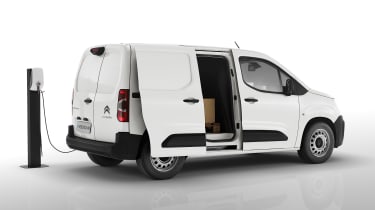
Citroen e-Berlingo
The Stellantis Group – parent company of Citroen, Peugeot and Vauxhall – is launching electric versions of all its compact vans in 2021. Citroen's offering is called the e-Berlingo (the same name as the seven-seat passenger version) and comes with a 50kWh battery for a range of up to 171 miles, along with a 134bhp electric motor for a top speed of up to 81mph. A wallbox charger will top up the battery in around five to seven hours, while 50kW rapid-charging capability allows for a 30-minute replenishment to 80% from public points. The e-Berlingo is offered in two or three-seat configurations and in two sizes, with load lengths from 3.09 to 3.44 metres, load volumes from 3.3 to 4.4 cubic metres, a maximum payload of 800kg and maximum towing weight of 750kg. Read more about the Citroen e-Berlingo here.
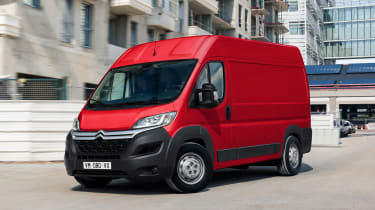
Citroen e-Relay
Sitting above the e-Berlingo and the already-on-sale e-Dispatch in the Citroen electric-van range, the e-Relay is offered with two battery sizes: 37 or 70kWh. The former gives the van a claimed 73-mile range, while the latter can take it 139 miles before needing a top-up. The shorter-range battery is offered with the L2 body length exclusively, while the L3 and L4 lengths come with the longer-range battery. All body lengths are available in panel-van form, while the L3 offers the option of a chassis cab and L4 offers the option of a window van. Maximum payload is from 740 to 1,150kg and maximum load volume is from 11.5 to 15 cubic metres. Read more about the Citroen e-Relay here.
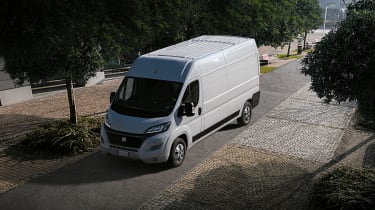
Fiat e-Ducato
A sister model to the Citroen e-Relay above, as well as the Peugeot e-Boxer and Vauxhall Movano-e below, the e-Ducato was announced in July 2019, before the merger between Citroen and Peugeot's parent PSA and Fiat's parent FCA came about. Fiat says the E-Ducato will be offered in the same range of body variants as the diesel equivalent, with load volumes from 10 to 17 cubic metres and a maximum payload of 1,950kg. Its motor will produce just over 120bhp, while different battery sizes will offer ranges from 146 to 230 miles in urban driving conditions. Read more about the Fiat e-Ducato here.
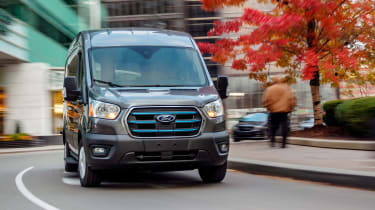
Ford E-Transit
Sales of the pure-electric Ford E-Transit start in early 2022, entering a market that'll be full of similarly large and capable electric vans. Power comes from a 265bhp electric motor and 67kWh battery, with a claimed range of 217 miles. Ford will offer the E-Transit in panel-van, double-cab-in-van and chassis-cab versions as part of a line-up of 25 possible configurations, to include different wheelbase lengths and body heights. The van will also be packed with up-to-date driver-assistance, safety and fleet-management systems. Read more about the Ford E-Transit here.
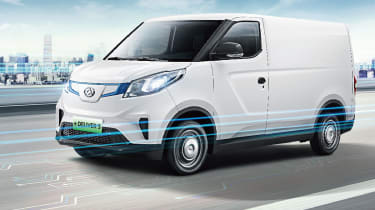
Maxus eDeliver 3
The eDeliver 3 was first unveiled at CV Show in 2019 as the LDV EV30, but following LDV's rebranding as Maxus early in 2020, it was renamed. A smaller counterpart to the company's eDeliver 9 (below) the zero-emissions small van comes in two body lengths (short and long wheelbase) offering drivers flexibility in terms of payload and carrying capacity. There's also two battery sizes: 52.5kWh (for up to 149 miles on a charge from the short-wheelbase model, or 142 from the long-wheelbase) and 35kWh, which gives the short and long-wheelbase versions ranges of 98 and 93 miles respectively. Read more about the Maxus eDeliver 3 here.
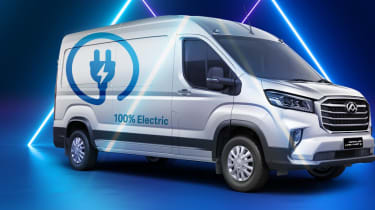
Maxus eDeliver 9
The eDeliver 9 offers a larger load volume and carrying capacity than the smaller eDeliver 3 (above). It's available in two different sizes (medium and long-wheelbase) and offers a range of up to 219 miles on a charge. A 201bhp electric motor drives the wheels, drawing power from one of three available battery sizes: 52, 72 or 89kWh. Cargo volume for the medium-wheelbase eDeliver 9 is 9.7 cubic metres, while the long-wheelbase model can accommodate 11 cubic metres. Maximum payload is up to 1,700kg. Read more about the Maxus eDeliver 9 here.
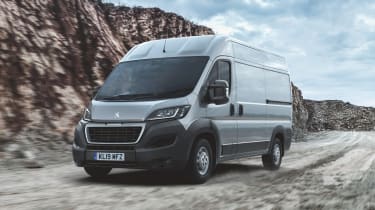
Peugeot e-Boxer
A sister model to the Citroen e-Relay and Fiat e-Ducato above, as well as the Vauxhall Movano-e below, the e-Boxer is another large electric van from the Stellantis Group. It's offered in three different body lengths (L2, L3 and L4) and a single body height (H2), offering up to 15 cubic metres of load volume and a maximum payload of up to 1,150kg. Power comes from a 120bhp electric motor, fed by either a 37 or 70kWh battery. The smaller battery is available with the L2 and L3 body lengths and gives the van a 73-mile range, while the larger can be fitted to the L3 and L4 versions, for 139 miles' driving range. The e-Boxer comes with 22kW fast charging as standard; it's capable of taking an 80% charge from a public charger in an hour. The 37 and 70kWh versions will charge in five and nine hours respectively from a 22kW wallbox (usually fitted at commercial premises), while a 7kW domestic wallbox will do the same job in six and 12 hours respectively. Read more about the Peugeot e-Boxer here.
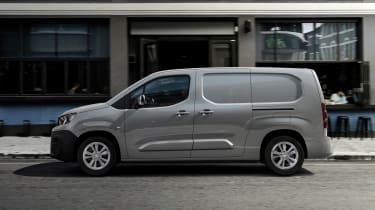
Peugeot e-Partner
Peugeot's equivalent to the Citroen e-Berlingo and Vauxhall Combo-e shares most of its vital stats with its Stellantis Group sister models. That means a 50kWh battery for an expected maximum driving range of 171 miles, along with a 134bhp electric motor. Two body lengths are being offered – the 4.4-metre 'Standard' and the 4.75-metre 'Long' – as well as three-seat panel van and five-seat crew van configurations. Maximum towing capacity is 750kg and maximum payload is up to 800kg. Load volumes of up to 4.4 cubic metres (for the Long) and up to 3.8 cubic metres (for the Standard) are identical to those of the equivalent diesel-engined Partners. Read more about the Peugeot e-Partner here.
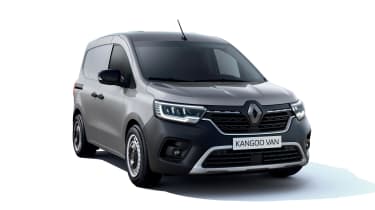
Renault Kangoo E-TECH
With the current electric Kangoo lagging behind the competition, Renault has announced its replacement. The new Kangoo E-TECH has been shown in official images, but details are fairly slim for now; it's expected to use an improved drivetrain shared with the latest Nissan Leaf, thanks to the partnership between the two firms. Two body lengths will be offered, along with improvements to infotainment, driver-assistance technology and build quality. There's no official launch date yet, but some point in 2021 is likely. The new Kangoo will also form the basis of a next-generation Nissan electric van to replace the e-NV200. Read more about the Renault Kangoo E-TECH here.
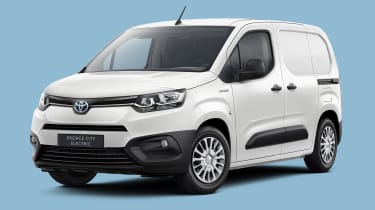
Toyota Proace City Electric
Although Toyota isn't part of the Stellantis Group, it does have an agreement to rebadge the group's light commercial vehicles for the European market. This has given us the already-on-sale Toyota Proace Electric (sister model to the mid-size Citroen e-Dispatch, Peugeot e-Expert and Vauxhall Vivaro-e) and will shortly add another contender in the compact segment in the shape of this Proace City Electric. This model shares technology with the Citroen e-Berlingo, Peugeot e-Partner and Vauxhall Combo-e listed elsewhere in this article, so expect the same 50kWh battery and 134bhp electric motor, for a range of around 170 miles in ideal conditions. Read more about the Toyota Proace City Electric here.
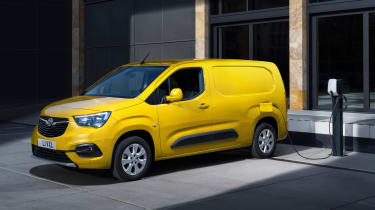
Vauxhall Combo-e
With Vauxhall now fully integrated into the Stellantis Group, it's no surprise to find that its Combo-e small electric van will mirror the specifications of the Citroen e-Berlingo and Peugeot e-Partner listed above. It uses the same 50kWh battery and 134bhp electric motor, for an estimated driving range of 171 miles. Acceleration from 0-60mph takes 11.2 seconds and top speed is capped at 80mph to preserve range. Rapid charging will be supported at speeds up to 100kW, which is sufficient for an 80% top-up in 30 minutes. The Combo-e will be available in two lengths, with a maximum payload of up to 800kg and a load volume of 3.8 or 4.4 cubic metres. The crew variant will seat up to four passengers as well as the driver, with cargo and equipment safely stowed behind the bulkhead. Read more about the Vauxhall Combo-e here.
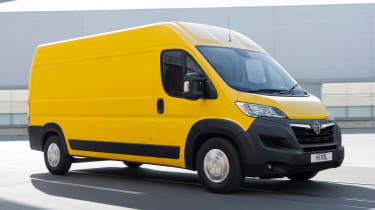
Vauxhall Movano-e
The mid-size Vauxhall Vivaro-e is already on sale, and by the end of 2021 the British brand's zero-emissions light-commercial line-up will be completed by the Combo-e (above) in the compact class and this Movano-e in the large class. A sister model to the aforementioned Citroen e-Relay, Fiat e-Ducato and Peugeot e-Boxer, it'll come with either a 37 or 70kWh battery, for a maximum range of 72 or 129 miles respectively. Both models will use a single 120bhp electric motor, while there'll be a choice of four wheelbase lengths (L1, L2, L3 and L4) and three heights (H1, H2 and H3), for a maximum cargo volume of up to 17 cubic metres – the same as the latest diesel Movano. The maximum payload of 2,100kg is also identical to what the diesel can manage. Read more about the Vauxhall Movano-e here.
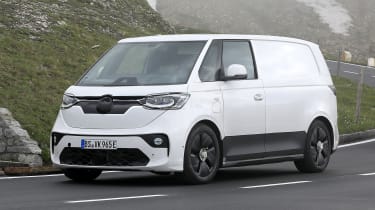
Volkswagen ID. Buzz
Perhaps the most eagerly anticipated of all the electric vans on this list, the VW ID. Buzz differs from almost all of its competitors in that it's built on dedicated electric-vehicle architecture, rather than being adapted from a diesel-engined van platform. Under the metal, it uses parts from the same VW Group electric-car 'toolkit' that underpin the Volkswagen ID.3 hatchback and Skoda Enyaq iV SUV. The ID. Buzz hasn't been officially unveiled yet, but lightly disguised prototypes (pictured) have been spotted testing. Exact specs have also yet to be confirmed, but battery capacities from 48 to 111kWh are expected, for an estimated driving range of up to 340 miles. Both single and dual-motor layouts are anticipated, too, with a 201bhp output and 99mph top speed for the former. Read the latest about the Volkswagen ID. Buzz here.
Source: https://www.drivingelectric.com/news/622/new-electric-vans







Tidak ada komentar:
Posting Komentar